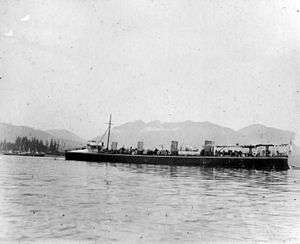HMS Sparrowhawk (1895)
 In Burrard Inlet, BC, Canada circa 1898 | |
| History | |
|---|---|
| Name: | HMS Sparrowhawk |
| Builder: | Laird, Son & Co., Birkenhead |
| Yard number: | 607 |
| Laid down: | 30 May 1895 |
| Launched: | 8 October 1895 |
| Commissioned: | July 1897 |
| Fate: | Wrecked, 17 June 1904 |
| General characteristics | |
| Class and type: | Quail-class destroyer |
| Displacement: |
|
| Length: | 218 ft (66.4 m) |
| Beam: | 21 ft 6 in (6.55 m) |
| Draught: | 9 ft 6 in (2.90 m) |
| Propulsion: |
|
| Speed: | 30 knots (56 km/h; 35 mph) |
| Complement: | 63 |
| Armament: |
|
HMS Sparrowhawk was a B-class torpedo boat destroyer of the British Royal Navy. She was completed by Laird, Son & Company, Birkenhead, and was launched on 8 October 1895. [1] She served on the China Station and was wrecked in the mouth of the Yangtze River in 1904.[2] She was one of four Quail-class destroyers.
Design and construction
HMS Sparrowhawk was the second of four 30-knot destroyers ordered from Laird's as part of the 1894–1895 Royal Navy shipbuilding programme.[3] As with other early Royal Navy destroyers, the detailed design was left to the builder, with the Admiralty laying down only broad requirements.[4][5] In order to meet the contract speed of 30 knots (35 mph; 56 km/h), Laird's design was powered by two four-cylinder triple expansion steam engines, fed by four Normand boilers, rated at 6,300 ihp (4,700 kW), and was fitted with four funnels.[3][6]
The ship had an overall length of 218 feet (66.45 m), a beam of 21 feet 6 inches (6.55 m) and a draught of 9 feet 6 inches (2.90 m). Displacement was 355 long tons (361 t) light and 415 long tons (422 t) full load,[3][6] while crew was 63.[7] Armament consisted of a QF 12 pounder 12 cwt (3 in (76 mm) calibre) gun on a platform on the ship's conning tower (in practice the platform was also used as the ship's bridge), with a secondary armament of five 6-pounder guns, and two 18-inch (450 mm) torpedo tubes.[8][9]
Sparrowhawk was laid down as Yard No 607 on 30 May 1895, and was launched on 8 October 1895.[10] She reached a speed of 30.207 knots (34.762 mph; 55.943 km/h) over a measured mile and an average speed of 30.56 knots (56.60 km/h; 35.17 mph) over three hours during trials on 11 December 1896.[11] Sparrowhawk commissioned in June 1897.[10]
Service
Newly commissioned, Sparrowhawk took part in the naval review off Spithead on 26 June 1897 to celebrate the Diamond Jubilee of Queen Victoria.[12] Laird's thirty-knotters were considered strongly built ships and good seaboats, suitable for deployment on overseas stations,[13][6] and so Sparrowhawk and sister ship Virago were deployed to the Pacific Station in 1897, being based at Esquimault, British Columbia, Canada.[14]
Sparrowhawk was later deployed to the China Station. On 17 June 1904, Sparrowhawk struck an uncharted rock off the mouth of the Yangtze river during fleet exercises. While all the crew survived, attempts by the battleship Glory to recover the stricken destroyer failed, and Sparrowhawk sank.[15][16][17]
References
- ↑ The Times (London), Wednesday, October 9, 1895, p.7
- ↑ "HMS Sparrowhawk". pbenyon.plus.com. Retrieved 12 July 2010.
- 1 2 3 Lyon 2001, pp. 61–62.
- ↑ Chesneau and Kolesnik 1979, p. 87.
- ↑ Manning 1961, p. 39.
- 1 2 3 Chesneau and Kolesnik 1979, p. 94.
- ↑ Manning 1961, p. 40.
- ↑ Lyon 2001, pp. 98–99.
- ↑ Friedman 2009, p. 40.
- 1 2 Lyon 2001, p. 61.
- ↑ "Eight Torpedo Boat Destroyers, Built by Laird Brothers, Birkenhead. — Trials between 30th September and the 18th December 1896" (PDF). The Engineer. Vol. 83. 1 January 1897. p. 16..
- ↑ "HMS Sparrowhawk". pbenyon.plus.com. Retrieved 18 October 2014.
- ↑ Lyon 2001, p. 116.
- ↑ Lyon 2001, pp. 62, 100.
- ↑ Lyon 2001, p. 62.
- ↑ "British Navy: Destroyers in Trouble. Two Sunk". Kalgoorlie Miner. 21 June 1904. p. 5. Retrieved 19 October 2014.
- ↑ "Loss of H.M.S. Sparrowhawk". The Mercury. Hobart, Australia. 8 August 1904. p. 4. Retrieved 19 October 2014.
- Chesneau, Roger; Kolesnik, Eugene M (1979). Conway's All The World's Fighting Ships 1860–1905. London: Conway Maritime Press. ISBN 0-85177-133-5.
- Friedman, Norman (2009). British Destroyers: From Earliest Days to the Second World War. Barnsley, UK: Seaforth Publishing. ISBN 978-1-84832-049-9.
- Lyon, David (2001). The First Destroyers. London: Caxton Editions. ISBN 1-84067-3648.
- Manning, T. D. (1961). The British Destroyer. London: Putnam & Co. Ltd.